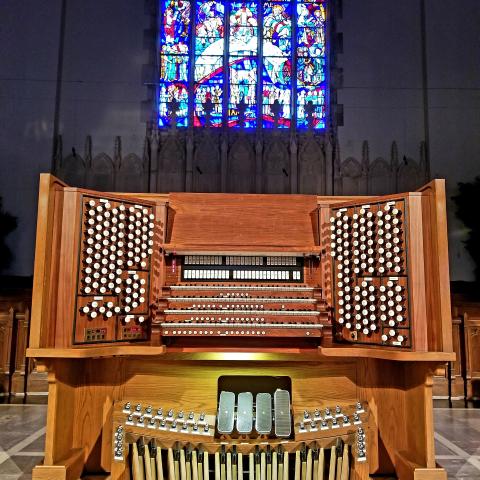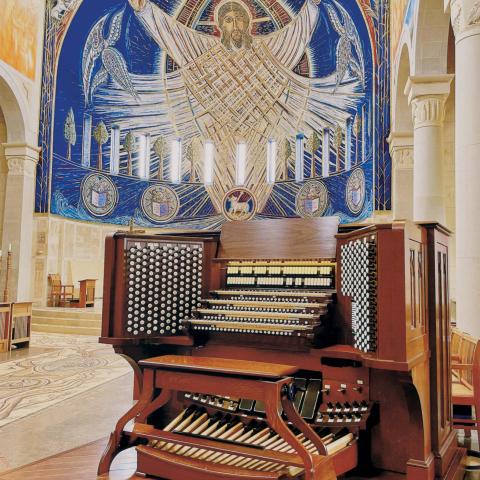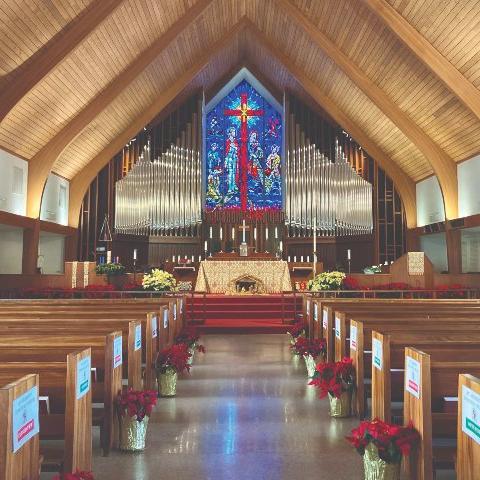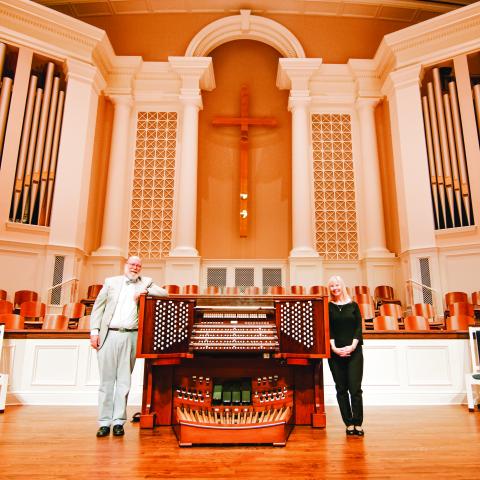The First Church, UCC, Nashua, New Hampshire
Austin Organs, Inc., Hartford, Connecticut, Opus 1406
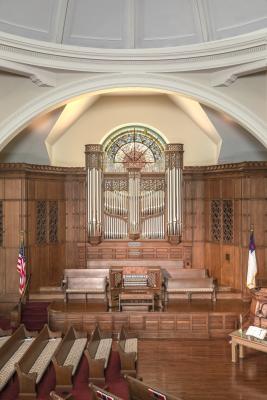
From the Minister of Music and Consultant
When I was appointed Minister of Music in 2008, the organ was to be on the docket for a long-anticipated restoration early in my tenure. Upon learning about the vision for this instrument that was started under Dr. Robin Dinda, FAGO, in the early 1990s, two things were clear: the Young Memorial Console built by Austin in 1996 prepared the organ for significant expansion, and a new floating Solo division was to be part of this vision.
Over the years, attempts were made to undo tonal changes from the 1970s and 1980s (primarily light upperwork in the Great), which sacrificed some of the instrument’s most beautiful original softer stops. At some point in the past two decades, the original enclosed Great 8′ Gemshorn (once stored inside the organ casework) disappeared, as well as the original 8′ Harmonic Tuba. A significant, but somewhat misguided change to the entire Great division in the early 2000s continued to take the instrument away from its original symphonic roots. The “return” to these 1926 roots ultimately became the basis for our church’s $2.3 million Capital Campaign for Ministry, Music, and Mission in 2014.
This vision would be to restore the organ to its 1926 tonal specification and nomenclature and add new upperwork, scaled and voiced in typical 1920s Austin character. The original tonal design had no mixtures or mutations and only one 2′ stop (in the Swell). The existing stewardship of our 1996 three-manual console guided us in adding the prepared floating Solo division, with an eye toward more liturgical function rather than tonal tradition. In effect, we now have a III/47 versatile main instrument, with a 13-rank Solo (with two composite stops) bringing the total rank count to 60—an instrument easily suited for four manuals, but keeping former stewardship and sightline considerations in check for a three-manual console, with many options.
The Solo was designed with double-sided nave and chancel sets of swell shades. This allows use of the Solo division not only as a powerful solo voice (or part of the greater organ ensemble) but also adds the possibility of accompanying a choir from that area of the sanctuary with closed shades and Pedal stop additions. Consequently, the new division also assists our 5-octave bell choir, through a tonal reference closer to their placement in the church.
Austin concentrated on securing Austin (or similar) pipework from the original era, and where vintage pipes could not be sourced, Austin provided new pipework made to patterns Austin used in the 1920s. As a result, we have a thrilling instrument with a 21st-century eye towards its 1926 heritage—an impressive, warm sound over six divisions, and one of the most flexible accompanying instruments in Northern New England. Four celestes (three string and one flute) add wonderful warmth. Original color stops like the Vox Humana and vintage Harp (and classic fan tremulants) deliver sounds of yesteryear. The organ features complete string, flute, and diapason ensembles, with reeds (some independent and some unit treatments), and has retained the original two full-length 16′ reeds under expression! The versatility of the instrument is astounding, especially when one utilizes sub/super-coupling and unisons off. The return of 23 ranks of extension octaves (73 notes) provides a thrilling shimmer that can compete with the best of Boston’s local craze with Skinner and Aeolian-Skinner.
Two of the organ’s returned softest stops, the Swell 8′ Echo Salicional, (1930 Midmer-Losh) and the Enclosed Great 8′ Gemshorn (1925 Austin) have added sensitive softer dynamics, which now allow the instrument to offer every variation from ppp to ffff. Masterful tonal finishing led by Daniel Kingman, Austin’s senior voicer and associate tonal director, truly kept everything warm, lush, and never shrill. Full organ never “screams.” Additions to the instrument include the three-rank Solo Vox Seraphique (15th, 17th, 19th), a 1924-vintage harmonics stop that is designed to pair with the Major Gamba and Celeste to create a unique shimmer and color combination; this is a rare effect found in perhaps only a very small handful of instruments. The large-scaled Mounted Cornet IV in the Solo is designed to pair with the Solo’s Doppelflute, and also pairs with the new linen-lead pattern, leather-lipped Grand Diapason on the Open Great. This near-Stentorphone color alone fills the room with a sound long forgotten (and greatly misunderstood) in the days of American Classic and Neo-Baroque revival.
Complex “borrows” of stops, either as new divisional extensions, or in the Pedal, add amazing variations to registration. Cross-coupling of the Enclosed Great and Choir (to the Choir and Swell respectively) allows a flexibility unparalleled for an organ of this size. The mechanics are truly an engineering marvel, and every ounce of possibility was brought out of this instrument’s re-design, thanks to collaboration with the Austin staff.
I am privileged to sit at this console every week and was truly honored to serve as the principal consultant for this important and historic work. Thanks are due in particular to Charles Morris who acted as the church’s representative. The team at Austin was accommodating of nearly anything asked of them. The extension of the case and grillework for the new Solo division truly looks like it has always been in the sanctuary. The resulting instrument thrills congregation, recitalists, and audiences alike. By offering a minimum of seven public programs featuring the Anderson Memorial Organ annually on our First Music Concert Series, the organ’s voice is widely heard in this region and has garnered much regional attention, in print and on television—as the most significant organ project in the state of New Hampshire in a decade. It is an honor to be at the helm of this historic ministry, now with an instrument that will continue to praise God for generations to come. Soli Deo Gloria.
—Joseph R. Olefirowicz, CAGO
Minister of Music
Principal Organ Consultant
From the Builder
On our preliminary visit to the church, we were introduced to an instrument built by Austin some 90 years previous that was barely an echo of what had been installed. The contract was signed on December 19, 1925, with promised completion by September 1, 1926. By today’s standards, this timeframe would be unheard of, since a 3-manual, 42-stop instrument would surely require a minimum of 16 to 24 months. In 1925, however, the company was in the epoch of its greatest production, shipping nearly two organs per week. This contract was signed on behalf of Austin by Elisha Fowler of Boston, formerly of the Hutchings Company, but since 1919 served as New England (and later Midwest) sales representative for Austin. Also a seasoned tonal designer, Mr. Fowler likely had strong influence in drawing up the tonal specification for this organ. One interesting element in the contract stated that:
The Austin Organ Company hereby guarantees tonal satisfaction to Mrs. Frank Anderson, donor; Earl F. Nauss, minister; and Maurice Hoffman, organist; and agrees to exchange any and all pipes which do not satisfy and to continue to do so until results satisfactory to the committee named have been attained.
Perusing the files, no pipes appeared to have been returned by order of the committee; a happy circumstance that must have caused sighs of great relief in Hartford!
The organ was initially scaled rather heroically on wind pressure of seven inches water column. The Great Principal Diapason was 40 scale (nearly 6¾ inches diameter at bottom C). There was an accompanying “Small Diapason” of 46 scale, which is a scale that would be typical of instruments built in the late 1960s to 1970s. A revision in March of 1926 shows that the Principal Diapason bass was changed to 43 scale and the Small Diapason to 49 scale. This would be more in keeping with other similar instruments of the time in typical rooms. In today’s thinking, the 43 scale/17th ratio is typical of German Normalmensur, while the 49-scale Diapason (with a narrow mouth) is typical of a Violin Diapason and would be a bit more incisive. Likewise, the Swell Diapason bass was changed from 40 scale to 43. This provided the power and color in the manual range, without excessive heaviness in the pedal; it also consumed less windchest real estate.
The tonal palette of this instrument was certainly typical for the era and boasted a plethora of fundamental stops; absent were mixtures or mutations. Similar organs of the period—for example, Opus 1409 at St. John’s Episcopal Church in Bridgeport, Connecticut, an instrument of 75 stops—boasted upperwork and a full set of independent mutations in the Swell, including a Nazard, Flautina, Tierce, Septieme, and Twenty Second. (An interesting side note, this organ appears to be the first instance found of an Austin with double expression—a box within a box—in the Swell department.) Mixtures were found in several instruments of the period, but usually confined to the Swell Organ. A notable exception is Austin Opus 1416, for the Sesquicentennial Exposition, built in 1926. At 162 ranks—it was for many generations the largest pipe organ built by Austin under a single contract. Each of the principal divisions has multiple ranks of mixtures; and of course, reed choruses, flute choruses, strings, mutations, etc.
Armed with this history, we surveyed the condition of this venerable instrument in Nashua. The organ had been a victim of several attempts at “tonal modernization” over the years. Diapasons had been removed and replaced with lighter-scaled pipework; a rather large mixture was added to the Great; and the Tuba was removed and replaced with a poorly recycled supply-house Trumpet. Also, the enclosed divisions had several stops removed, altered, or replaced entirely with random pipework. Many hours of discussion were spent attempting to recreate, or frankly create a new tonal specification that would echo the vision for this instrument, as if a time machine had transported us back to 1926, but with greater resources available, such as were reserved for larger instruments as mentioned above.
The result of fraternal collaboration between Joseph Olefirowicz and the Austin staff was to create a tonal design that could have been lifted from Austin’s archives. The overall limit of the “new” specification was perhaps a bit exhaustive, but the result is an extremely versatile instrument with amazing tonal variety and possibilities.
In our grand scheme, a significant addition was the inclusion of a new Solo division. There was space allowed on the 1996 console, and we were offered the possibility of utilizing a pass-through storage area located on the far right of the organ case. To transform this space into an organ chamber would require the construction of some new casework with additional tone openings. The existing organ has some unique carving that resembles vines within its openings. We scanned images of this casework and created a CAD file that was turned into magnificent scaled panels identical to the original. The Solo was voiced to speak on 10 inches wind pressure, typical of the era, which required the installation of an additional blower. To accommodate this requirement, we pulled a vintage Spencer blower from our inventory and sent it back to the factory for refurbishment and a new motor equipped with a variable frequency drive controller.
Upon completing the design phase, reality struck a severe chord when the actual challenge of building this instrument necessitated sourcing the required pipes to achieve the desired result. In some cases, it was as simple as making (or finding) an octave or a few pipes to restore scaling; many of the 73-note extension octaves had been lost to time, but happily we were able to source replacements for all of those lost from vintage inventory. In other cases we required complete stops; many were procured from Austin’s inventory. Some stops were new manufactured pipes made to vintage Austin patterns. An example is the 8′ Bassoon in the Great. While perhaps not typical of the time, there was a desire and need for a lighter chorus reed in the exposed division. This particular pattern was originally used in Opus 1010 (c. 1921 in the Eastman Theatre, Rochester New York) and also in Opus 1109 (1922, at the Cincinnati Music Hall). The original patterns were located in our archive and used for this instrument. Likewise, vintage patterns likely used for the original pipes in 1926 were used for the replacement Tuba in the Great. Conversely, we chose a vintage E. M. Skinner pattern for the Solo Tuba—for variety of dynamic and color. The Solo English Horn was sourced from vintage inventory, a 1924 Austin instrument.
We feel that this instrument embodies not only the 1920s tonal concepts, as detailed herein, but Austin’s design paradigm—a concept we refer to as Symphonic-Liturgical Tonal Design
It is arguable that the most advanced form of musical expression we celebrate today is the symphony orchestra. It is a comprehensive and versatile entity. Evidence of this fact is provided by reviewing any concert program. On any given evening, one can encounter a most sublime movement from Ravel; just a moment later, the terrific thunder crash of a powerful Wagnerian overture! These variations in repertoire, dynamic, and emotion are all delivered by the same performers and the same instruments. In much the same way, a well-designed tonal palette in an organ capable of supporting these timbres and styles gives an organist the ability to perform with similar flexibility.
Why do we consider this ability to be important?
The pipe organ in church today must bridge the gap between traditional solo organ literature, liturgical accompaniment, choral support, and yet have the ability to perform contemporary accompaniment and literature. One can only imagine where the next trend might lead! The tone of the instrument must be pleasing—but not that alone—for the instrument must be capable of fulfilling its role in the liturgy. In summation: the organ must be extremely versatile and able to be play almost any literature, and the organ’s tonality also has to be outstanding in its conceptualization, voicing, and disposition.
We feel that the Austin organ is built of the most solid construction to support the extra demands placed on a symphonic organ. Our design (the famed Austin Universal Airchest System) assures the church of steady wind, ease of maintenance, and maximum utilization of available space. We strive to build the most comfortable organ consoles with the finest control systems available.
The sound of an Austin organ plenum (tonal ensemble) is unique. To achieve our desired level of warmth and simultaneous transparency requires not only our specific style of voicing, but very close attention to pipe scaling, regulation, and of great importance, explicit confidence in our Austin Universal Airchest System.
Celebrating 125 years of pipe organ building experience, and our dedicated staff comprising one of the oldest pipe organ factories in the country; we are ready to build one of the finest instruments possible, and then provide ongoing support and service.
—Michael Fazio
President & Tonal Director
Austin Organs, Inc.
Austin team members involved with Opus 1406 renovation:
Raymond Albright
Michael Chiradia
Bruce Coderre
Colin Coderre
Jacob Dowgewicz
Michael Hart
Curt Hawkes
Victor Hoyt
Dan Kingman
Rafael Ramos
David Secour
Stewart Skates +
Richard Taylor
Tony Valdez
Anne Wysocki
Mike Fazio
GREAT ORGAN (* = enclosed Great)
16′ Major Diapason 73 pipes
8′ Grand Diapason 73 pipes
8′ Principal Diapason 73 pipes
8′ Small Diapason (ext) 12 pipes
8′ Flauto Major (Ped 16′ Dia) 41 pipes
8′ Violoncello * 73 pipes
8′ Gemshorn * 73 pipes
8′ Bourdon * 73 pipes
8′ Flute Celeste (Ch)
8′ Unda Maris (Ch)
4′ Octave 73 pipes
4′ Principal * 73 pipes
4′ Harmonic Flute * 73 pipes
22⁄3′ Twelfth 61 pipes
2′ Fifteenth 61 pipes
IV Fourniture (19-22-26-29) 244 pipes
16′ Tuba * (ext) 12 pipes
8′ Harmonic Tuba * 61 pipes
8′ Bassoon 73 pipes
4′ Clarion * (ext) 12 pipes
Harp (Ch)
Chimes 25 tubes
Tremulant *
SWELL ORGAN
16′ Bourdon 73 pipes
8′ Open Diapason 73 pipes
8′ Rohr Flute 73 pipes
8′ Viole D’Orchestre 73 pipes
8′ Viole Celeste (TC) 61 pipes
8′ Echo Salicional 73 pipes
4′ Fugara 73 pipes
4′ Flauto Traverso 73 pipes
4′ Violina (ext)
22⁄3′ Nasard 61 pipes
2′ Flageolet 61 pipes
13⁄5′ Tierce 61 pipes
III Mixture (15-19-22) 183 pipes
16′ Contra Posaune 73 pipes
8′ Tuba Mirabilis (Solo)
8′ Cornopean 73 pipes
8′ Oboe 73 pipes
8′ Vox Humana 61 pipes
Tremulant
CHOIR ORGAN
16′ Quintade (ext) 12 pipes
8′ Geigen Principal 73 pipes
8′ Concert Flute 73 pipes
8′ Flute Celeste (TC) 61 pipes
8′ Dulciana 73 pipes
8′ Unda Maris (TC) 61 pipes
8′ Quintadena 73 pipes
4′ Geigen Octave (ext)
4′ Flute D’Amour 73 pipes
2′ Piccolo 61 pipes
11⁄3′ Larigot 61 pipes
16′ Tuba (Gt)
8′ Harmonic Tuba (Gt)
8′ Clarinet 73 pipes
4′ Tuba Clarion (Gt)
Harp (Austin) 61 bars
Chimes (Gt)
Tremulant
SOLO ORGAN
8′ Doppelflute 73 pipes
8′ Major Gamba 73 pipes
8′ Gamba Celeste 73 pipes
4′ Flute Ouverte 73 pipes
4′ Gambette (ext) 12 pipes
4′ Gambette Celeste (ext) 12 pipes
III Vox Seraphique (15-17-19) 183 pipes
IV Mounted Cornet (TC) (8-12-15-17) 196 pipes
8′ Cor Anglais 73 pipes
8′ Tuba Mirabilis 73 pipes
Tremulant
Nave Shades Off
Chancel Shades Off
PEDAL ORGAN
32′ Diapason (Resultant)
32′ Bourdon (Resultant)
32′ Lieblich Gedeckt (Resultant, Sw)
16′ Open Diapason 32 pipes
16′ Violone (Gt)
16′ Bourdon 32 pipes
16′ Flute Bass (ext, Solo) 12 pipes
16′ Quintaten (Ch)
16′ Lieblich (Sw)
8′ Octave (Gt)
8′ Major Flute (Solo)
8′ Gross Flute (ext 16′ Diap) 12 pipes
8′ Flauto Dolce (ext 16′ Bdn) 12 pipes
4′ Super Octave (Gt)
4′ Flute (Sw)
32′ Grand Cornet (Resultant)
16′ Tuba (Gt)
16′ Posaune (Sw)
8′ Tuba Mirabilis (Solo)
8′ Harmonic Tuba (Gt)
4′ Clarion (Gt)
Chimes (Gt)
Pedal to Pedal 4
EXPRESSION PEDALS
Choir/Enclosed Great
Swell
Solo
Register Crescendo
CONTROLS
999-levels of memory
Bridal signal (HCTB)
Clock
Continuo
“Go-to” function
Manual Transfer
Piston sequencer
Playback
Transposer
Ventil (mixtures)
Ventil (reeds)
Builder’s website: http://austinorgans.com
Church’s website: tfcucc.org
Photo credit: Len Levasseur

